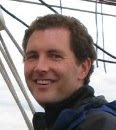Since I've been remiss in getting pictures on the blog, here is a sampling of how Connor has been spending the last few months in Gamboa.
Tuesday, May 13, 2008
Western Highlands
Since I've been remiss in getting pictures on the blog, here is a sampling of how Connor has been spending the last few months in Gamboa.
Saturday, March 1, 2008
Javier sighting
Fast forward to December 2007, when I went to Coiba National Park with Tina and Carwyn via Santa Catalina. I asked the scuba guys if they knew a gringo named Javier who might have bought land in Santa Catalina 13 years ago, and they did! So once back in Sta. Catalina, I asked around and found Javier's house, right in the center of town - and there was Javier! We were in a major rush to get cleaned up and catch the last bus out that night that might or might not be running so we just had a few minutes to catch up. In short, Javier has been living the good life in Santa Catalina (with some time in Santiago) all these years, including living off the land/sea as a subsistence fisherman for 6 years. He's now married to a lovely local woman named Kenia and they have 2 sweet kids. And he looks pretty much the same! They built a sweet house in the center of town that they rent out and have recently started running ecotours to Coiba - check out the Casa Kenia website. Well, we were lucky and caught the bus - and the bus driver didn't mind stopping outside Javier's house so Tina could document our Javier sighting:
In February our friends Jamie & Summer came to visit. And what they really wanted to do was go to Coiba. What could we say - no?? Especially since John hadn't been, and we only have 4 more months here... So we e-mailed Javier to see if he could set up a trip on short notice. Javier was able to accommodate us. The five of us (Summer, Jamie, John, Kirsten & Connor) spent 3 days/2 nights in Coiba with Javier. It was great - great snorkling, some excellent hikes, a flock of scarlet macaws - and time to catch up with Jav. We'll post pix soon!
Wednesday, February 6, 2008
Research Highlight
My research will show how some forest songbirds use degraded, fragmented forest habitats. In
I am capturing, radiotagging and releasing individual birds from three focal species: the dusky antbird, red-throated ant tanager, and cocoa woodcreeper. The three species are different sizes and from different bird families, and are all relatively common in the forests of central

tanager, woodcreeper, and male and female antbirds (clockwise)
Once a bird is radiotagged, we track the bird’s movements and record behavior and habitat types during 1-hour observation periods. Using GIS software to compile land cover and land use data, we compare relocations of each individual bird with the habitat and surrounding landscape. The resulting data will be analyzed to determine if each species has particular habitat preferences, if their behavior or movement rates are different in different habitats or edge types, and how large a gap or forest opening the birds will cross.
Working with Isis Ochoa to tag a bird
During field work in 2007, we radiotagged and tracked 39 individuals in three sites. Preliminary analyses indicate that dusky antbirds and red-throated ant tanagers are largely confined to forest habitat, that is, they do not use the more-open habitat surrounding forests. Cocoa woodcreepers spend most of their time in forest habitat but will also forage on individual trees growing in park-like surroundings and back yards. Both woodcreepers and ant tanagers were observed crossing gaps of up to 30 m to move from one forest patch to another. All three species were observed foraging in and moving through edges of forests, and are able to use edgy, patchy habitat as long as there is sufficient forest.
Work planned for 2008 will include surveys of forest patches that are different sizes and that are different distances from other forests. I will use the results from the radiotracking study and studies by other STRI researchers to make predictions of the minimum size of a forest patch necessary for several songbird species. I will then test these predictions with the new survey data. Together with the complete results from the radiotracking study, this research will provide conservation planners with critical information about the species expected to persist in highly fragmented, human-dominated landscapes, and what types of land uses are compatible with providing habitat to birds.
I am being supported for 15 months in 2007-2008 at the Smithsonian Tropical Research Institute
Teaching Panamanian biologists about radiotelemetry
Wednesday, January 23, 2008
Birthday and Christmas Pictures

Lots more pictures in the album.

Monday, January 7, 2008
Christmas in Panama
We also enjoyed traveling with Derek, Ilse and Jim in the week before Christmas. In the meantime here is our Christmas card picture
 which hopefully will arrive to you soon!
which hopefully will arrive to you soon!Kirsten and Connor had a good time on Coiba, and I managed for 3 days even without our daily phone call. Some non-diving pics (from Tina of course).
And finally, another album from our Gamboa Thanskgiving, with some nice shots of Kirsten playing flag football (I was the photographer for that portion of the day, you might notice we are less well-represented afterwards).







